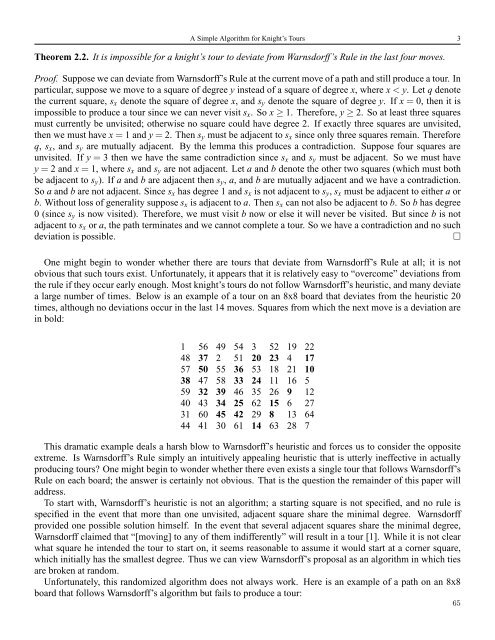A SIMPLE ALGORITHM FOR KNIGHT'S TOURS Chess is a two ...
A SIMPLE ALGORITHM FOR KNIGHT'S TOURS Chess is a two ...
A SIMPLE ALGORITHM FOR KNIGHT'S TOURS Chess is a two ...
Create successful ePaper yourself
Turn your PDF publications into a flip-book with our unique Google optimized e-Paper software.
A Simple Algorithm for Knight’s Tours 3Theorem 2.2. It <strong>is</strong> impossible for a knight’s tour to deviate from Warnsdorff’s Rule in the last four moves.Proof. Suppose we can deviate from Warnsdorff’s Rule at the current move of a path and still produce a tour. Inparticular, suppose we move to a square of degree y instead of a square of degree x, where x < y. Let q denotethe current square, s x denote the square of degree x, and s y denote the square of degree y. If x = 0, then it <strong>is</strong>impossible to produce a tour since we can never v<strong>is</strong>it s x . So x ≥ 1. Therefore, y ≥ 2. So at least three squaresmust currently be unv<strong>is</strong>ited; otherw<strong>is</strong>e no square could have degree 2. If exactly three squares are unv<strong>is</strong>ited,then we must have x = 1 and y = 2. Then s y must be adjacent to s x since only three squares remain. Thereforeq, s x , and s y are mutually adjacent. By the lemma th<strong>is</strong> produces a contradiction. Suppose four squares areunv<strong>is</strong>ited. If y = 3 then we have the same contradiction since s x and s y must be adjacent. So we must havey = 2 and x = 1, where s x and s y are not adjacent. Let a and b denote the other <strong>two</strong> squares (which must bothbe adjacent to s y ). If a and b are adjacent then s y , a, and b are mutually adjacent and we have a contradiction.So a and b are not adjacent. Since s x has degree 1 and s x <strong>is</strong> not adjacent to s y , s x must be adjacent to either a orb. Without loss of generality suppose s x <strong>is</strong> adjacent to a. Then s x can not also be adjacent to b. So b has degree0 (since s y <strong>is</strong> now v<strong>is</strong>ited). Therefore, we must v<strong>is</strong>it b now or else it will never be v<strong>is</strong>ited. But since b <strong>is</strong> notadjacent to s x or a, the path terminates and we cannot complete a tour. So we have a contradiction and no suchdeviation <strong>is</strong> possible.□One might begin to wonder whether there are tours that deviate from Warnsdorff’s Rule at all; it <strong>is</strong> notobvious that such tours ex<strong>is</strong>t. Unfortunately, it appears that it <strong>is</strong> relatively easy to “overcome” deviations fromthe rule if they occur early enough. Most knight’s tours do not follow Warnsdorff’s heur<strong>is</strong>tic, and many deviatea large number of times. Below <strong>is</strong> an example of a tour on an 8x8 board that deviates from the heur<strong>is</strong>tic 20times, although no deviations occur in the last 14 moves. Squares from which the next move <strong>is</strong> a deviation arein bold:1 56 49 54 3 52 19 2248 37 2 51 20 23 4 1757 50 55 36 53 18 21 1038 47 58 33 24 11 16 559 32 39 46 35 26 9 1240 43 34 25 62 15 6 2731 60 45 42 29 8 13 6444 41 30 61 14 63 28 7Th<strong>is</strong> dramatic example deals a harsh blow to Warnsdorff’s heur<strong>is</strong>tic and forces us to consider the oppositeextreme. Is Warnsdorff’s Rule simply an intuitively appealing heur<strong>is</strong>tic that <strong>is</strong> utterly ineffective in actuallyproducing tours? One might begin to wonder whether there even ex<strong>is</strong>ts a single tour that follows Warnsdorff’sRule on each board; the answer <strong>is</strong> certainly not obvious. That <strong>is</strong> the question the remainder of th<strong>is</strong> paper willaddress.To start with, Warnsdorff’s heur<strong>is</strong>tic <strong>is</strong> not an algorithm; a starting square <strong>is</strong> not specified, and no rule <strong>is</strong>specified in the event that more than one unv<strong>is</strong>ited, adjacent square share the minimal degree. Warnsdorffprovided one possible solution himself. In the event that several adjacent squares share the minimal degree,Warnsdorff claimed that “[moving] to any of them indifferently” will result in a tour [1]. While it <strong>is</strong> not clearwhat square he intended the tour to start on, it seems reasonable to assume it would start at a corner square,which initially has the smallest degree. Thus we can view Warnsdorff’s proposal as an algorithm in which tiesare broken at random.Unfortunately, th<strong>is</strong> randomized algorithm does not always work. Here <strong>is</strong> an example of a path on an 8x8board that follows Warnsdorff’s algorithm but fails to produce a tour:65
















